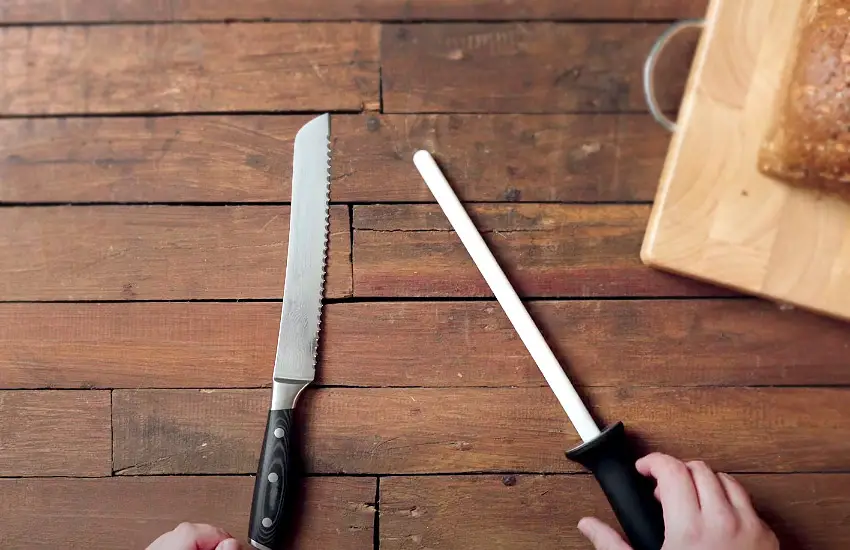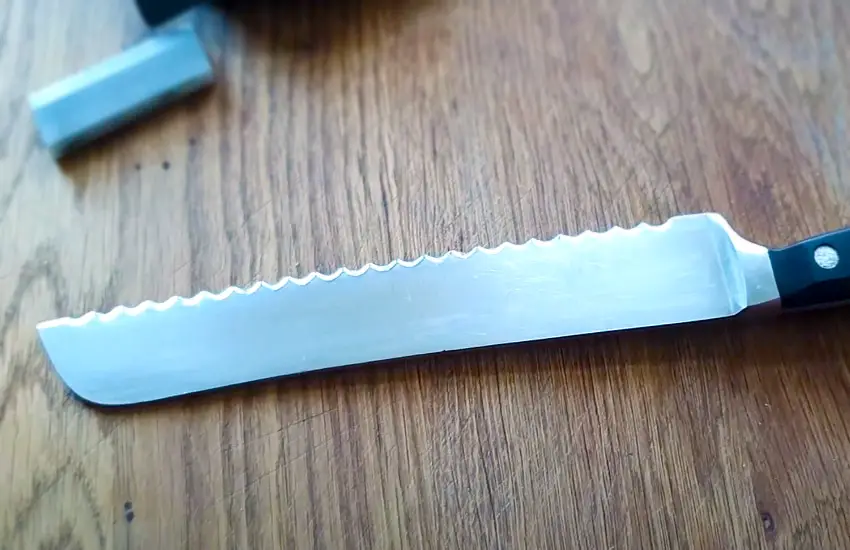As an Amazon Associate, I earn from qualifying purchases at no extra cost to you.
How to Sharpen a Serrated Bread Knife at Home: Expert Tips
A sharp serrated bread knife is essential for effortless slicing of bread, pastries, and other delicate baked goods. Over time, the teeth of the serrated blade may become dull, resulting in less precise cuts. Instead of replacing the knife, you can easily sharpen it at home to restore its cutting performance.
This article will guide you through the process of sharpening your serrated bread knife at home using the right tools and techniques. With a few easy steps, you’ll have a sharp serrated knife ready to tackle your favorite breads.

Why Sharpening A Serrated Bread Knife Is Important
Sharpening a serrated bread knife is important for several reasons:
Ensuring Clean Cuts
When a serrated bread knife becomes dull, it can tear and crush the loaf rather than slicing through it cleanly. Sharpening the knife ensures that the serrations are sharp and aligned, enabling it to make clean cuts without damaging the texture of the bread. This is particularly important when working with delicate pastries and artisan bread with crusty exteriors.
Improving Knife Performance
A sharp serrated bread knife not only provides clean cuts but also enhances its overall performance. By sharpening the blade, you can improve its ability to effortlessly glide through bread, resulting in a more pleasant and efficient cutting experience. This increased performance can make kitchen tasks like slicing bread or cakes much easier and more satisfying.
Understanding The Anatomy Of A Serrated Bread Knife
The Blade
The blade of a serrated bread knife is unlike that of a traditional straight-edge knife. It features a series of teeth or serrations along one side, which are responsible for effortlessly sawing through the crusty exterior of bread while maintaining the delicate interior. To maintain sharpness, it’s important to understand the unique anatomy of the blade.
The Teeth
The teeth are the defining feature of a serrated bread knife. These small, pointed serrations grab onto the bread’s crust, allowing you to saw back and forth with minimal effort. Over time, however, these teeth can lose their sharpness, leading to tearing instead of clean slices. Understanding how the teeth are formed and how they function is crucial for effectively sharpening your bread knife.
The Handle
While the blade and teeth are the primary focus when it comes to sharpening a serrated bread knife, understanding the handle’s anatomy is equally important. The handle is where you grip the knife, providing stability and control as you slice through your favorite loaf. A comfortable and secure handle ensures safe and efficient use, making the sharpening process much smoother.
When it comes to sharpening a serrated bread knife at home, understanding the anatomy of the blade, teeth, and handle is the first step towards successfully revitalizing your knife’s cutting power. By gaining insight into these key components, you’ll be equipped with the knowledge needed to confidently maintain your knife’s sharpness and continue enjoying those perfectly sliced pieces of bread every time you reach for your trusty bread knife.
Tools And Materials Needed For Sharpening
Sharpening a serrated bread knife at home requires a few essential tools and materials to get the job done effectively. By investing in the right equipment, you can easily restore your dull knife’s sharpness and achieve clean, precise cuts with ease. Here are the key tools and materials you’ll need for sharpening:
Sharpening Stone
A sharpening stone is a must-have tool for sharpening your serrated bread knife. It is designed specifically for restoring the sharpness of knives and can be found in various grit levels, ranging from coarse to fine. The coarse grit helps in removing any nicks or burrs, while the fine grit ensures a polished, sharp edge.
Stabilizing Surface
A stable surface is essential to keep your sharpening stone secure during the sharpening process. Opt for a sturdy workbench or countertop, or use a non-slip mat or a damp towel to prevent any movement. By stabilizing the surface, you’ll have better control over the knife and ensure consistent sharpening.
Lubricating Oil
Using lubricating oil during the sharpening process helps reduce friction and prevents the stone from clogging with metal particles. It also helps to keep the knife cool while sharpening, preventing any heat damage. You can use specialized sharpening oil or other alternatives like mineral oil or water, depending on the type of sharpening stone you have.
Now that you know the essential tools and materials needed for sharpening your serrated bread knife at home, it’s time to proceed with the sharpening process. In the upcoming sections, we’ll guide you through step-by-step instructions to bring back your knife’s sharpness and enhance your bread slicing experience.
Step-by-Step Guide to Sharpen Your Serrated Bread Knife
Sharpening a serrated bread knife can be a bit more challenging than sharpening a straight-edged knife, but it’s definitely doable. Here’s a step-by-step guide to help you sharpen your serrated bread knife effectively:

Preparing The Knife
To begin the sharpening process, gather the necessary tools. You’ll need a serrated bread knife, a sharpening rod or stone, and a damp cloth. Make sure the knife is clean and dry before you start. Lay out the damp cloth on a flat surface to provide stability for the knife during sharpening.
Honing The Teeth
Hold the knife firmly in one hand and use the sharpening rod in the other. Position the rod so that it matches the angle of the serrated teeth on the knife. Gently slide the rod along each tooth, applying light pressure to sharpen and realign the edges. Repeat this process for every tooth on both sides of the blade.
Stropping The Blade
After honing the teeth, it’s essential to strop the blade to remove any remaining burrs and achieve a razor-sharp edge. Fold a piece of leather in half and use it to run the entire length of the blade, ensuring an even finish. Perform smooth and consistent strokes to polish the blade and ensure a precise cutting edge.
Additional Tips for Serrated Bread Knife Maintenance
Here are a few additional tips to help you get the most out of your serrated bread knife sharpening:
-
Frequency of Sharpening: Serrated knives typically require less frequent sharpening compared to straight-edged knives. However, if you notice a decrease in cutting performance or if the knife starts to tear rather than slice through bread cleanly, it’s time to sharpen it.
-
Use Proper Technique: Whether you’re using a handheld sharpener or a sharpening rod, maintain a consistent angle while sharpening. For most serrated knives, a 20 to 25-degree angle works well. This ensures that you’re sharpening the beveled edge effectively without removing too much material.
-
Consider Professional Sharpening: If you’re uncomfortable sharpening your serrated bread knife yourself or if it requires significant repair, consider taking it to a professional knife sharpener. They have the expertise and specialized equipment to sharpen serrated knives properly.
-
Regular Maintenance: To extend the time between sharpening sessions, use a honing steel or ceramic rod to realign the edge of your serrated knife regularly. This helps maintain its sharpness and prevents the need for frequent sharpening.
-
Protect the Edge: After sharpening, store your serrated bread knife in a knife block or sheath to protect the freshly sharpened edge from damage. Avoid storing it loosely in a drawer where it could come into contact with other utensils and become dull.
-
Practice Patience: Sharpening a serrated bread knife may take a bit more time and patience compared to sharpening a straight-edged knife. Take your time and focus on maintaining a consistent angle and applying even pressure to achieve the best results.
By following these additional tips, you’ll be better equipped to sharpen your serrated bread knife effectively and keep it performing at its best for years to come.
Final Words
Sharpening a serrated bread knife at home is a simple and cost-effective way to keep it performing at its best. With the right tools and technique, you can easily maintain the sharpness of your knife for smooth and effortless slicing.
Regular maintenance will extend the lifespan of your knife, ensuring it stays a valuable asset in your kitchen.
